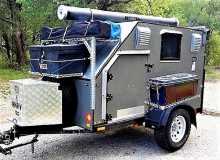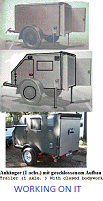- There's another thread currently running about extensions for towing. Not wanting to hijack another thread, I'll ask my question here. In this picture from my gallery, you can see that my truck is too high for proper alignment with my trailer.
- I'd like to drop it about 8", without having to buy another Weight Distributing shank. The one I currently use is perfect for my wife's 20ft Palomino Puma QB trailer, and for my 18ft car hauler. I can't get any more drop from it, nor do I want to switch heights on a regular basis. I've spotted a possible quick-change adapter solution.
- There are hi-low adapters made for leveling towed cars (behind motorhomes), but the adverts warn "not for trailers" . If you examine this photo, the hi low seems better constructed than some spindly straight extensions I've seen, and the 140 lb tongue weight (even with the added force of the WD spring bar attachment) of my trailer shouldn't even be close to the 400 lb tongue weight this hi low is rated for. The question is : has anyone tried this before, and with what results? I may not need that much more drop; I think 6" might be perfect, and thus less stress would be generated on it as well. I'm not a structural engineer, but a shade-tree mechanic. ????
hi low adapter for level towing
10 posts
• Page 1 of 1
hi low adapter for level towing
Last edited by working on it on Mon Jul 02, 2018 1:02 pm, edited 1 time in total.
2013 HHRv "squareback/squaredrop", rugged, 4x8 TTT, 2225 lbs


- *3500 lb Dexter EZ-Lube braked axle, 3000 lb.springs, active-progressive bumpstop suspension
- *27 x 8.5-14LT AT tires (x 3) *Weight Distribution system for single-beam tongue
- *100% LED's & GFCI outlets, 3x fans, AM/FM/CD/Aux. *A/C & heat, Optima AGM, inverter & charger(s)
- *extended-run, on-board, 2500w generator *Coleman dual-fuel stove & lantern, Ikea grill, vintage skillet
- *zinc/stainless front & side racks *98"L x 6" diameter rod & reel carrier tube on roof
-

working on it - 2000 Club

- Posts: 2189
- Images: 457
- Joined: Tue Oct 04, 2011 9:05 pm
- Location: DFW Texas
Re: hi low adapter for level towing
I don't know why that would specifically say "not for trailers", but they do make specific rise/drop ball mounts similar to what you're showing.
Here's one for a 2" hitch, 8" drop.....

https://www.etrailer.com/Ball-Mounts/Hi ... 80213.html
And if that's too much drop, here's a 6" drop....

https://www.etrailer.com/Ball-Mounts/Hi ... 80240.html
Here's one for a 2" hitch, 8" drop.....

https://www.etrailer.com/Ball-Mounts/Hi ... 80213.html
And if that's too much drop, here's a 6" drop....

https://www.etrailer.com/Ball-Mounts/Hi ... 80240.html
-

absolutsnwbrdr - Donating Member
- Posts: 2657
- Images: 412
- Joined: Mon Jan 25, 2010 6:10 pm
- Location: Hanover, PA


